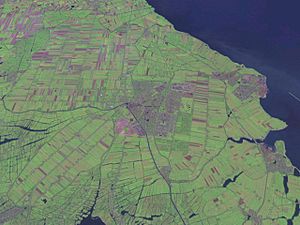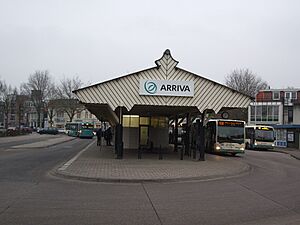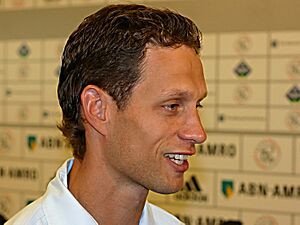Purmerend facts for kids
Quick facts for kids
Purmerend
|
|||
|---|---|---|---|

Purmerend city centre
|
|||
|
|||

Location in North Holland
|
|||
| Country | Netherlands | ||
| Province | North Holland | ||
| Region | Amsterdam metropolitan area | ||
| Government | |||
| • Body | Municipal council | ||
| Area | |||
| • Total | 24.56 km2 (9.48 sq mi) | ||
| • Land | 23.39 km2 (9.03 sq mi) | ||
| • Water | 1.17 km2 (0.45 sq mi) | ||
| Elevation | 0 m (0 ft) | ||
| Population
(May 2014)
|
|||
| • Total | 79,532 | ||
| • Density | 3,400/km2 (9,000/sq mi) | ||
| Demonym(s) | Purmerender | ||
| Time zone | UTC+1 (CET) | ||
| • Summer (DST) | UTC+2 (CEST) | ||
| Postcode |
1440–1448
|
||
| Area code | 0299 | ||
Purmerend is a city and a municipality in the western part of the Netherlands. It is located in the province of North Holland. The city is surrounded by polders, which are low-lying lands that used to be lakes. Some of these polders are the Purmer, Beemster, and Wormer.
Purmerend's population grew a lot after the 1960s. It went from about 10,000 people to over 80,000 by 2020. Because of this growth, Purmerend became a "commuter town." This means many people who live there travel to Amsterdam for work, school, or fun. Purmerend is also part of the Randstad, which is one of the largest groups of cities in Europe.
On January 1, 2022, the municipality of Beemster joined with Purmerend. Now, the larger municipality has a population of about 92,000 people.
Contents
History of Purmerend
How Purmerend Started
Purmerend began as a small fishing village called Purmer. This village was on a piece of land between three lakes: the Purmermeer, the Beemstermeer, and the Wormermeer. It was also on the south bank of a river called De Weere. This river used to connect the Purmermeer and Beemstermeer.
A rich banker from Amsterdam named Willem Eggert founded Purmerend. In 1410, Count William VI of Holland gave him permission to build a strong castle called Slot Purmerstein. The castle was finished in 1413, and this led to the town of Purmerend being created. The castle was taken down in 1741 because it was old and falling apart.
In 1434, Purmerend was given "city rights." This meant it could act more like a city. Then, in 1484, it got "market rights" from Count Jan van Egmond. This allowed Purmerend to hold two yearly markets and one weekly market. Before this, only food for the local people could be sold. After 1484, merchants from outside Purmerend could also sell their goods there.
Purmerend in the 1600s
By the year 1500, Purmerend had grown quite a bit. Old maps show it had a rectangular shape with two main roads crossing it. One road went north-south, and the other went east-west.
In 1612, the Beemster Lake was drained, and in 1622, the Purmer Lake was drained. This meant Purmerend lost many of its fishing areas. However, the new, rich soil was great for agriculture (farming) and raising livestock (farm animals). This helped Purmerend become successful again. The city became a center for selling farm products from the surrounding area.
Purmerend in the 1800s
From 1819 to 1824, the Noordhollandsch Kanaal (North Holland Canal) was built. This canal followed old waterways and connected Purmerend to the IJ river near Amsterdam. It also connected Purmerend to Alkmaar. A large lock, called the Schutsluis Purmerend, was finished in 1821 just west of the city center.
The Noordhollandsch Kanaal brought more wealth to Purmerend. Companies like Brantjes en Comp and Firma Dirk Bakker started trading wood. Ships from countries like Norway, Sweden, Russia, and America began sailing directly to Purmerend to deliver wood. Sometimes, as many as 12 large ships would be there at once.
This increase in trade and shipping led to new businesses that helped ships. Purmerend merchants even started preparing ships for whalers (people who hunt whales). In 1866, a company called Gebroeders Goedkoop started a tow service with 7 tugboats. This was a big moment for Purmerend. However, by about 1880, this busy time for Purmerend ended. A new canal, the North Sea Canal, opened and ships started using that route instead.
Purmerend in the 1900s
During World War II, German forces took control of Purmerend on May 14, 1940. After five years, the city was freed by Canadian and other allied forces on May 9, 1945.
Purmerend in the 2000s
In 2003, Purmerend was called the "Funfair City of the Netherlands" (Kermisstad van Nederland). The city is also famous for its cattle market, known as the koemarkt (cow market). Here, animals like cows and sheep are bought and sold. The cattle market was closed for a while between 1995 and 2001. It reopened in January 2002, but on a smaller scale.
For 400 years, the cattle market was in the center of Purmerend. But in 2008, it moved to the "Baanstee Oost" industrial area, on the north side of the city. This move helped reduce traffic in the city center and provided more parking. It also gave the market more space for auctions and made it easier for trucks to move around.
Geography and Climate of Purmerend
Understanding Purmerend's Geography
Purmerend is in a wet and swampy area called Waterland. When the first people settled here, the land was mostly made of veen (turf). They dug ditches that ran side-by-side to drain away extra water. Because of this, the land started to sink. This meant people always had to fight against the water, and farming was very difficult back then.
It also meant that any structure had to be built on a raised area, either a natural hill or an artificial terp. Purmerend itself was built on the bank of the river De Where, which connected the old Beemster and Purmer lakes.
Purmerend's Districts
Purmerend is divided into several areas called districts. These include:
- Centrum
- Zuiderpolder
- Overwhere-Noord
- Overwhere-Zuid
- De Gors
- De Gors-Zuid
- De Gors-Noord
- West
- Purmer-Zuid
- Purmer-Noord
- Wheermolen
- Weidevenne
- Baanstee-West
- Baanstee-Oost
- Baanstee-Noord
- De Koog
- Molenkoog
- Hazepolder
- Kop van Noord
The municipality of Purmerend also includes the small towns or hamlets of Purmerbuurt and part of the Purmer. The Purmer area is shared with two other municipalities, Edam-Volendam and Waterland.
Purmerend's Climate
Purmerend has a mild climate. Here's a look at the average temperatures throughout the year:
| Month | JAN | FEB | MAR | APR | MAY | JUN | JUL | AUG | SEP | OCT | NOV | DEC | Year |
|---|---|---|---|---|---|---|---|---|---|---|---|---|---|
| Avg high °C (°F) |
5.4 (41.7) |
6.0 (42.8) |
9.2 (48.6) |
12.4 (54.3) |
17.1 (62.8) |
19.2 (66.6) |
21.4 (70.5) |
21.8 (71.2) |
18.4 (65.1) |
14.1 (57.4) |
9.2 (48.6) |
6.5 (43.7) |
13.4 (56.1) |
| Avg low °C (°F) |
0.5 (32.9) |
0.2 (32.4) |
2.4 (36.3) |
4.0 (39.2) |
7.8 (46.0) |
10.4 (50.7) |
12.5 (54.5) |
12.3 (54.1) |
10.2 (50.4) |
7.0 (44.6) |
3.9 (39.0) |
1.9 (35.4) |
6.1 (43.0) |
| Source: [KNMI http://www.knmi.nl/] | |||||||||||||
Getting Around Purmerend: Public Transport
Public transportation in Purmerend mostly connects to Amsterdam. There are several bus services and a train service that goes through Zaandam.
Purmerend has three train stations:
- Purmerend Overwhere (in the North)
- Purmerend (in the Centre)
- Purmerend Weidevenne (in the South)
The main bus station in Purmerend is called "Tramplein," which means Tram Square. This name comes from the past, when a tram called "'t Boemeltje" used to run from Amsterdam Centraal to Purmerend, ending at this square. Even after the tram service stopped, the name "Tramplein" stayed.
In 1951, a band called The Ramblers even had a popular song about this tram service, called "’t Boemeltje van Purmerend."
In 2019, the province of North Holland announced plans to extend the Amsterdam Metro's Noord-Zuidlijn (North-South line) from Noord station all the way to Purmerend.
Famous People Born in Purmerend
Many interesting people were born in Purmerend:
- Jan Stuyt (1868–1934), a Dutch architect.
- Pieter Oud (1886–1968), a Dutch politician who was a Minister of finance and Mayor of Rotterdam.
- Jacobus Oud (1890–1963), a Dutch architect who followed the De Stijl art movement.
- Mart Stam (1899–1986), an architect, city planner, and chair designer.
- Hendrik de Wit (1909–1999), a Dutch botanist who studied plants.
- Leen Verbeek (born 1954), a Dutch politician who was the Mayor of Purmerend from 2003 to 2008.
- Jan van Zanen (born 1961), a Dutch politician who was the Mayor of Utrecht from 2014 to 2020.
- Hans Klok (born 1969), a Dutch magician and illusionist.
- Duncan Stutterheim (born 1971), a Dutch business owner who started the event company ID&T.
- Kim van Kooten (born 1974), a Dutch actress and screenwriter.
- Fleur Agema (born 1976), a Dutch politician and former designer.
- Janey Jacké (born 1992), a Dutch drag performer who appeared on Drag Race Holland (season 1) and RuPaul's Drag Race: UK vs the World.
Sports Stars from Purmerend
Purmerend has also produced many talented athletes:
- Martin Koeman (1938–2013), a Dutch footballer who played as a defender.
- Kees Nierop (born 1958), a former Dutch racing car driver.
- Edwin Zoetebier (born 1970), a former football goalkeeper.
- Olaf Lindenbergh (born 1974), a former Dutch footballer.
- Vincent van der Voort (born 1975), a Dutch professional darts player.
- Yuri Rose (born 1979), a Dutch former midfielder and now a manager.
- Kees Kwakman (born 1983), a Dutch former professional footballer.
- Mitchell Dijks (born 1993), a football player.
- Jay Gorter (born 2000), a Dutch goalkeeper for Ajax.
International Connections: Sister Cities
Until 2017, Purmerend had a "sister city" relationship with:
|
Images for kids
See also
 In Spanish: Purmerend para niños
In Spanish: Purmerend para niños











